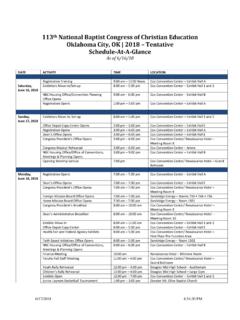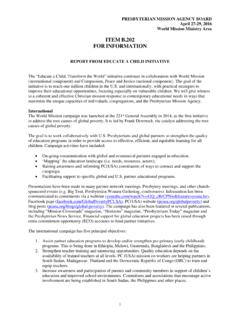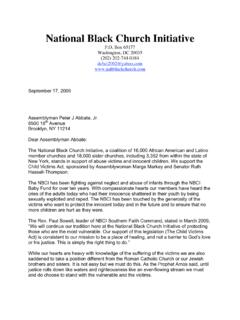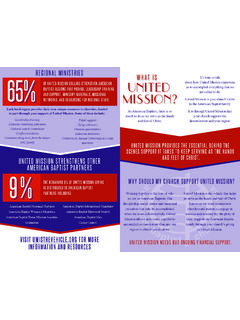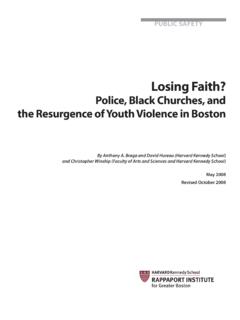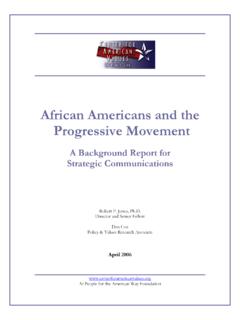Transcription of ENVIRONMENTAL JUSTICE, URBAN REVITALIZATION, AND ...
1 EPA 500-R-96-002. December 1996. ENVIRONMENTAL justice , URBAN revitalization , and brownfields : THE SEARCH FOR AUTHENTIC SIGNS OF HOPE. A Report on the "Public Dialogues on URBAN revitalization and brownfields : Envisioning Healthy and Sustainable Communities". national ENVIRONMENTAL justice Advisory Council Waste and Facility Siting Subcommittee Charles Lee, Chair A Federal Advisory Committee to the ENVIRONMENTAL Protection Agency This report was written by the Waste and Facility Siting Subcommittee of the national ENVIRONMENTAL justice Advisory Council (NEJAC).
2 The NEJAC is a federal advisory committee that was established by charter on September 30, 1993, to provide independent advice, consultation, and recommendations to the Administrator of the ENVIRONMENTAL Protection Agency (EPA) on matters related to ENVIRONMENTAL justice . This report has not been reviewed for approval by the Agency and hence, the contents of this report do not represent the views and policies of the ENVIRONMENTAL Protection Agency, nor of other agencies in the Executive Branch of the federal government.
3 This report is EPA Report number EPA 500-R-96-002. Additional copies of this report may be requested by contacting EPA=s Office of Solid Waste and Emergency Response Outreach and Special Projects Staff at 202-260-4039 or via E-mail at Comments or questions can be directed to EPA=s Office of ENVIRONMENTAL justice (OEJ) through the Internet. OEJ=s Internet E-mail address is: Executive Summaries of the reports of the NEJAC meetings are available on the Internet at OEJ=s World Wide Web homepage: Endorsement of this report does not constitute a NEJAC endorsement of any specific Brownfields initiative or the Brownfields concept in general.
4 Rather, it is an endorsement of the recommendations to help ensure that ENVIRONMENTAL justice , community participation, and URBAN revitalization concerns are addressed in Brownfields initiatives. A Federal Advisory Committee to the ENVIRONMENTAL Protection Agency national . ENVIRONMENTAL justice . ADVISORY COUNCIL. Carol Browner, Administrator July 29, 1996. ENVIRONMENTAL Protection Agency 401 M Street, SW. Washington, DC 20460. Dear Administrator Browner: Attached, please find a copy of the final report, " ENVIRONMENTAL justice , URBAN revitalization , and brownfields : The Search for Authentic Signs of Hope.
5 " At the May 29-31 meeting of the national ENVIRONMENTAL justice Advisory Council in Detroit, Michigan, the Council discussed the Waste and Facility Siting Subcommittee's report, " ENVIRONMENTAL justice , URBAN revitalization , and brownfields : The Search for Authentic Signs of Hope." The Council has agreed to endorse the report, as reflected in a formal mail vote, and to transmit it to you. The purpose of this letter is to request that you review the report and address the action items identified in the report.
6 We are transmitting this document to you on behalf of the members of the NEJAC. We do so with sincere gratitude for the many persons who gave tirelessly of their time, energy, and expertise to make the NEJAC. Public Dialogues on URBAN revitalization and brownfields an outstanding success. The report follows up on, and analyzes the findings from, the public dialogues on URBAN revitalization and brownfields which were held in June and July 1995. As you read this report, we hope you will appreciate the reasons for our sense of profound urgency regarding the issues raised in the report.
7 Sincerely, Richard Moore, Chair national ENVIRONMENTAL justice Advisory Council Charles Lee, Chair NEJAC Waste and Facility Siting Subcommittee cc: NEJAC Council Members DEDICATION. Dr. Jean Sindab, Director of ENVIRONMENTAL and Economic justice /Hunger Concerns for the national Council of Churches and a member of the national ENVIRONMENTAL justice Advisory Council, passed away on January 8, 1996 after a long and hard battle with cancer. Those of us who knew her well are deeply saddened by our loss.
8 In reflecting upon Jean's life, we realized that this report attempts to speak to some of the issues at the very core of her life's work. For example, she and I worked on developing an URBAN Strategies initiative for the national Council of Churches in the wake of events in South Central Los Angeles. She organized the black church Network on ENVIRONMENTAL and Economic justice . Jean chose to serve on the Waste and Facility Siting Subcommittee because of her interest in the job creation aspects of the Brownfields issue.
9 Her passion was the plight of inner city youth, and she clearly understood the linkages between living in degraded physical environments, mass alienation, and destructive violence. It can be said that her life's work was dedicated to the constant search for authentic signs of hope. Many formative concepts behind this report germinated during our discussions years before the establishment of the national ENVIRONMENTAL justice Advisory Council. Jean struggled mightily to attend all the NEJAC "Public Dialogues on URBAN revitalization and brownfields .
10 " She especially liked the idea of "Envisioning Healthy and Sustainable Communities." Despite her illness, she was able to attend our Public Dialogue in Boston, and we were indeed graced by her presence. We believe that the vision which this report hopes to articulate is one she embraced and dedicated her life to help realize. She helped me to formulate the question which pervades this report: Can the restoration of the physical environment become an anchoring point for economic, social, cultural, and spiritual renewal?











